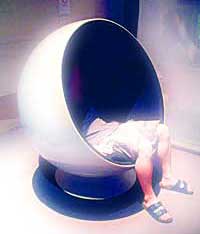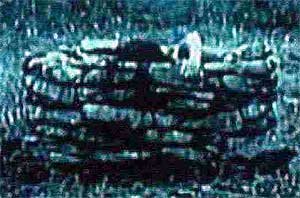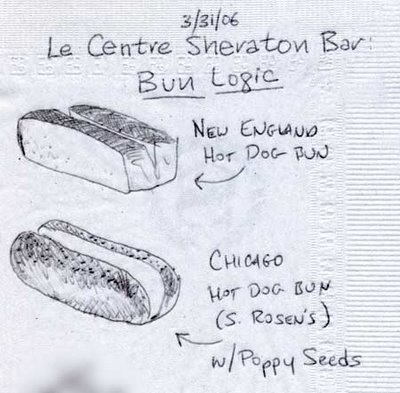Saturday, April 29, 2006

Like clockwork, each morning
the Umbrella Man walks
along the newly constructed 57th Street access path
past the Museum of Science and Industry
wearing
a decidedly unseasonable fur hat
a beige raincoat
an untrimmed beard
and oversized Harry Caray spectacles
his distinctive feature is the huge
vertically-hoisted
furled
leopard skin print parasol
he carries with the solemn mien of a Roman Legionnaire.
Friday, April 28, 2006
Here's a delighful excerpt from Andy Crouch's "The Best a Man Can Get," a thoughtful meditation on middle age, modern convenience, and the pursuit of the Perfect Shave. What is the morning shave, after all, but a quotidian reminder of renewed potential, revitalization, and the debridement of the last 24 hours' worth of life's debris? As our brains need to dream, so are we compelled to shave. While I don't need to worry about shaving my face every morning - or any morning, for that matter - I'm also 38, so a lot of what he writes here rings true...
[via Rebecca's Pocket] Do we have "the face we deserve" at forty? Maybe, maybe not...accidents of fate can disrupt our deserving faces' future in an instant, though the daily drip of time etches our faces to match our habitual expressions. If you wear a scowl at 20, you'll probably be wearing a permanent one at 40 or 50. A memorable face with character will age "well," even if youth's plump smoothness flies out the window. But IMHO, regardless of one's gender, wet shaving is the only way to go. Dry shaving is for the birds."...After the age of forty, every man is responsible for his own face." This aphorism, most commonly attributed to Albert Camus, was comforting when I heard it in my twenties. I was not given an easy face to be responsible for—angular, pale, and regularly visited, well into my thirties, by the acne that I was once assured was a passing adolescent tribulation. I took comfort not just in Camus's implied absolution for those faults dredged up from the Bennett and Crouch gene pools, but also in the promise that a life well lived might change my countenance, if not into that of a movie star, at least into a soft grandfatherly handsomeness. Forty also seemed comfortably far away, as distant a milestone as 21 once was. If nothing else, Camus's quote was yet another way to prolong adolescence (the state of mature irresponsibility, with or without acne) well into adulthood.
Now I am 38, two years away from Camus's benchmark. The only remaining milestone for maturity I can think of is fifty, the age of AARP membership and annual prostate exams. I am not sure I still find Camus's aphorism comforting. And thanks to Google I now know that Camus may not have meant to comfort me in any case, since the most common form of the quote begins with a word I never heard in my twenties: "Alas, . . ."
Alas, unless the next two years bring a sudden Botox-like transformation, the face I will be responsible for in my forties and beyond has quite as many faults as the one I was not responsible for in my twenties. And without a doubt, wet shaving has only made me more conscious of the face I am about to be responsible for. Every morning I stand in front of the mirror, naked from the waist up, and spend a good ten minutes peering intently at every angle and curve, every wrinkle and blemish. This is not, fundamentally, an encouraging experience.
I am not young anymore, I find myself thinking on these mirror mornings. I am not old, either, but I am old enough to be responsible. What have I done? What is there left for me to do? I have had a good, even wonderful, life so far, with vastly more than my share of blessing. I suspect I am far happier than Albert Camus. But who can go through forty years of this life, any life on this beautiful cursed earth, and not say, "Alas"?
But if Camus's slogan is no longer comforting, it has become bracing. Just in time, at the age of 38, I have learned how to shave. I have become responsible for my own face.[read full article]
Wednesday, April 26, 2006
 [Originally posted 4/26/2004]
[Originally posted 4/26/2004] So, my research into Chernobyl (which includes scouring the Web and government sites, and the University of Chicago and Harold Washington Libraries) has been slightly delayed. However, for the curious, I have a selection of choice hand-picked links that will provide multi-national insights into the incident, and its continuing aftermath.
UPDATED 4/26/2006:
Controversy over the "Kidd of Speed" website [NeilGaiman.com]
Ukraine Remembers Chernobyl Nuclear Accident [AP, CBS2 Chicago]
An extensive gallery of Chernobyl Images from the INSP (http://insp.pnl.gov/-library-uk_ch_1-1.htm)
BBC: Chernobyl 20 Years On
The German nuclear-safety agency GRS [Gesellschaft für Anlagen und Reaktorsicherheit, mbH] has a well-illustrated, informative 179-page free online technical report called "The Accident and the Safety of RBMK Reactors" [large PDF file, 5Mb].
If you enjoy government reports and "blue books," visit the World Nuclear Association's Chernobyl page, which includes links to UNSCEAR [United Nations Scientific Committee on the Effects of Atomic Radiation, which published several comprehensive reports on the Chernobyl disaster - many which are available here as free PDF downloads.
Watch This: Chernobyl.co.uk, a UK site which features a link to the BBC's recent 30-minute program [streaming RealPlayer video] on Chernobyl, featuring a look at the history of nuclear power in the former Soviet Union as well as a look inside Ukraine's Exclusion Zone towns. Highly recommended: this program illustrates that the deteriorating reactor site is still an issue of pressing concern through Europe, while it has been all but overshadowed here in the U.S.
Watch This: though the bulk of Chernobyl news coverage occurred before the age of streaming video, the post-date digitized BBC retrospective of the Chernobyl disaster [RealPlayer required] is a wistfully immediate - if lo-res - look back at those fateful days in April 1986.
Ukrainian biker gal (and young scientist) Elena is the Kidd [sic] of Speed: her wildly popular site, Ghost Town, features dozens of startling photos and rueful, blustering commentary from her motorcycle tour through the post-apocalyptic Exclusion Zone in Pripyat': part National Geographic expedition, part Jackass-meets-Evel Knievel. Strange thing is, I'd probably do it too, given the opportunity and a lead X-ray apron - but I'd prefer an enclosed vehicle, like a Bradley.
Got Euskadi? The Basque Website of Pripyat.
Have Paris, Rome, and the Caribbean lost their appeal? Been there, done that? How about a guided group tour through Chernobyl? I don't know if it's a legitimate enterprise, but you can apparently book a tour through the Exclusion Zone via Ukrainian Web Chyornobyl' Tour. You get complimentary disposable outerwear and shoes, and a souvenir computerized dosimeter printout that certifies how much radiation you absorbed during your visit.
The Jet Propulsion Laboratory's Pioneer Robot pages, with photos and diagrams of the Red Zone Robotics radiation-hardened explorer robot that will be used to excavate and explore the hot ruin inside the Sarcophagus.
A recent Kazakhstan Kazinform press release from March, 2004, warning that trouble at the Chernobyl Sarcophagus could be imminent.
From a nation that is also highly dependent on nuclear energy, but has thankfully suffered neither a Chernobyl nor a Three Mile Island type incident - the Canadian Nuclear Association's report on Chernobyl.
USGS satellite photos showing changes in the Chernobyl region from 1986 to 1992.
An August, 1986 EPA Bulletin on short-term American response to the Chernobyl disaster.
Gla55pak.com has compiled some unusual Chernobyl images here, and proclaims "I have a sick curiosity - more of an impulse - to be there that night and watch the thing light up. I would gladly take a good dose just to have seen it. It is, after all, like an immense train wreck that I just can't help but see." Also: link to Disenchanted.com's take on the Chernobyl and TMI incidents, called "Fear's just bad for business".
A high-resolution satellite image of the Chernobyl region from the Jet Propulsion Laboratory, suitable for desktop backgrounds.
Some of the best photos of the site I have seen are on the INSP's [International Nuclear Safety Program] Digital Library Website, where you can view over 800 color and black-and-white images, including the one at the top of this post.
Monday, April 24, 2006
 [This is the second in a series of archive pieces I'm re-posting in commemoration of the 20th anniversary of the Chernobyl tragedy, which occurred on April 26th, 1986. For more information, please visit RadioActive! The Nuclear Blog. Originally Posted May 15, 2004]
[This is the second in a series of archive pieces I'm re-posting in commemoration of the 20th anniversary of the Chernobyl tragedy, which occurred on April 26th, 1986. For more information, please visit RadioActive! The Nuclear Blog. Originally Posted May 15, 2004] "My search for information on Chernobyl has taken me to some very strange places.
This morning, I found this image on a fascinating Italian Chernobyl website, The Humus Project, or Progetto Humus, at http://www.progettohumus.it [the page this image appears on is here]. Look closely.
I can't verify its authenticity (unfortunately, many of the images lack captions or explanations) but it appears to be a shot of the glowing core of Chernobyl Reactor 4 shortly after the explosion. The timestamp on the image reads 01:23:59. But is it 1:23:59 AM on April 26th, 1986?
Thinkquest Library states that the containment lid of Reactor 4 blew off at 01:23:44 am, while the German 'Society for Plants and Reactor Safety', GRS (Gesellschaft für Anlagen und Reaktorsicherheit, in their technical report "The Accident and Safety of RBMK Reactors" [5Mb PDF file]) places the time of the explosion at:
01:24:00...[this] would be the first time I've been able to track down an image of the reactor in the earliest stages of the accident. I have not yet found an image of this type anywhere in Chernobyl literature, either on video, in books or and other source. Where did this come from, considering that the former Soviet Union did not inform the outside world of the explosion until days later? Was there a camera trained on the reactor? Did the image come from a flight over the reactor later than the timestamp indicates?
Recording of the shift supervisor: "Strong impacts, the shutdown systems stop before reaching the lower end position ..." Reactor excursion with more than 100 times of the nominal power. Explosion and destruction of the reactor core. The upper plate of the reactor is hurled up, all pressure tubes break off. Core material and burninggraphite parts are ejected. The reactor is burning, further fires start in the surrounding. Massive release of radioactive fission products.
Humus Project Chernobyl Video streams
Google Directory page for Science > Technology > Energy > Nuclear > Safety and Accidents > Chernobyl.
Belarus Guide on Chernobyl Information
Humus Project English version (Progetto Humus, Italy)"
Friday, April 21, 2006

- Stellastarr* - "My CoCo"
- Duke Ellington - "Wall Street Wail"
- Wall of Voodoo - "Elvis Bought Dora a Cadillac"
- Hawkwind - "Blue Skin"
- Joan Jett - "Wait For Me (Live NYC 1982)"
- Walter Wanderley - "Asa Branca"
- Franz Ferdinand - "You're The Reason I'm Leaving"
- The New Pornographers - "The Slow Descent Into Alcoholism"
- Thievery Corporation - "Tapis Rouge/Le Reveur"
- China Crisis - "Hanna Hanna"
Thursday, April 20, 2006
 UPDATE: According to a July 2005 WGN news story, "Except for those living in Los Angeles, Chicagoans drink more wine than residents of any other metropolitan area." The orchids will be very happy.
UPDATE: According to a July 2005 WGN news story, "Except for those living in Los Angeles, Chicagoans drink more wine than residents of any other metropolitan area." The orchids will be very happy.Are residents of the Edgewater neighborhood inveterate boozehounds? Judging from this news release passed on from the Edgewater Chamber of Commerce, we just might be....although I find it surprising that plushy Lincoln Park apparently needs to import corks from Edgewater for their orchid pots. *points nose upward with finger*
Cork It Again!
Cork comes from a tree and in countries where it grows like Portugal and Australia, recycling cork is popular. As part of its recycling initiative the Edgewater Chamber of Commerce is partnering with the Chicago Area Gay/Lesbian Chamber of Commerce to recycle corks. The collected corks are brought to the Lincoln Park Conservatory where they are used as a planting medium for orchids and to fill the bottoms of very large pots. Drop Your Cork Off at:
True Nature Foods
6030 N. Broadway, Chicago IL
Edgewater Chamber of Commerce
1210 W. Rosedale, Chicago IL
Monday, April 17, 2006
 ...a.k.a. the Solanaceae, a family of flora whose members encompass the deadly, the delirious, and the delicious:
...a.k.a. the Solanaceae, a family of flora whose members encompass the deadly, the delirious, and the delicious:They have sustained entire cultures, inspired artists and authors, enabled shamans to commune with spirits, assisted thugees, stunned animals, dilated pupils for eye exams and beauty, poisoned children, transformed boys and girls into adults, filled our bellies, fed addictions, stimulated our intellect and imagination, eased the pain of surgery, given cancer, inspired aesthetic delight, combatted inflammation and asthma, imparted solace during childbirth, and gave the gift and bane of spiritual flight to users, abusers, initiates, and Puritanical witches ...The Deadly Nightshade, a common creepy-crawler of roadside and alley with purple and yellow flowers that inflate to rainbow-colored half-inch berries was a favorite childhood fascination - for its brilliance, its potato-beetle attraction, and its mushy tomato-scented toxic fruitlets my little fingers loved to crush.
While not strictly "deadly," Solanum dulcamara (shown above) is a stomach-turning, often mind-altering plant if eaten in large quantities - not that that stopped me from chowing down on a few as a kid (how else would would I remember their stinging, green-tomatoey tang?). Some claim the nightshades are a toxin best avoided, others like myself savor their baroque flavorings as tomatoes, potatoes, peppers, chilies, chayote and eggplants*. The divine but deadly Datura, Mandrake, henbane and belladonna share filial ties with their culinary cousins...but I prefer ratatouille, chili or moussaka, ethnic Solanacaean delights.
* And tobacco, though I don't indulge in that particular nightshade. Just don't eat green potatoes with eyes.
Saturday, April 15, 2006
[Note: This is the first of a series of posts originally published on RadioActive!, one of my other blogs, which deals with nuclear energy and related issues. I'm reposting them here because this April 26th marks the 20th anniversary of the Chernobyl disaster. Ironically, two decades later the specter of nuclear war begins to loom again with reports of a potential international military standoff with the world's newest "member of the nuclear club," Iran. As the old saying goes, "those who do not learn from the past are condemned to repeat it." No truer words have ever been written.]
 April, 2004: "I'm still not certain what triggered it, but this weekend I started thinking about the Chernobyl disaster. True, it's a strange topic to suddenly become interested in, and I can't pinpoint any precipitating cause, such as a news story or random overheard conversation.
April, 2004: "I'm still not certain what triggered it, but this weekend I started thinking about the Chernobyl disaster. True, it's a strange topic to suddenly become interested in, and I can't pinpoint any precipitating cause, such as a news story or random overheard conversation. Considering that I had a major obsession with nuclear war back in the mid-1980's, I've been rather nuke-phobia-free for the last twenty years or so. The truth is, when Chernobyl's Reactor 4 exploded on April 26th, 1986, I don't remember being horribly concerned or glued to the television for news on the event. This can probably be explained by the fact that I was 18 at the time, and current events were rarely the stuff of daily obsession for me then. I think the zenith of my nuclear paranoia came in 1984 (Coincidence? We think not!), when my high school classes were periodically interrupted with fallout drills and regular lessons on Civil Defense Emergency evacuation procedure.
You see, I lived in Plattsburgh, New York back then - home to Plattsburgh Air Force Base, which was a prominent Northeast strategic ICBM target. What we were all told back then was basically that when the Russkies finally pressed the Big Red Button (of course, it would always be the Russkies pushing the button first), our immediate response should be to duck down under a table or desk, away from glass windows, place our heads protectively between our knees, and kiss our arses goodbye.
Between Ronald Reagan's regularly televised polemics, the "star wars" defense initiative, the Plattsburgh Yellow Pages' obligatory section on Civil Defense evacuation procedures (complete with maps where we should assemble with a change of warm clothing, canned food, jugs of clean water and prescription medications within ten minutes from when we first heard the alarm sirens, preparing to be bussed to safe locations before the Big One hit PAFB in 30 minutes - that's how long it would take the Russkies' ICBM's to strike our little air base) and songs like '99 Red Balloons' by Nena, 'Distant Early Warning' by Rush, 'Dancing With Tears In Our Eyes' by Ultravox (and many others) blaring sweaty repressed fear with a synth-and-guitar backbeat, I had recurring nightmares about nuclear war at least once a week back then.
Every time I heard a fire station call siren, I thought it might be The Big One. It got to the point that when I saw a flash of lightning to the eastern horizon, for a moment my heart skipped and I wondered whether my 30-minute timer had begun.
Sounds crazy, but those were crazy times. Who new that less than two years later, hell would break loose in the Ukraine, with a near-unstoppable radioactive fire spewing toxins into the Northern hemisphere upper atmosphere for nearly two weeks?
Compounding the Chernobyl event's mystery was the Soviet government's complete media silence about the accident for two days, only admitting to the disaster after a Swedish ambassador implored Moscow for answers why incredibly high levels of radiation were being detected in the Scandinavian nation for no apparent reason. Soon images of the reactor inferno reached the outside world, with accounts of brave, desperate virtually unprotected firefighters and helicopter pilots on suicide missions, struggling to put down the graphite moderator fire; the coverage near operatic in its dangerous grandeur and human pathos, a Götterdammerung of man against the mighty Atom unchained.
This past Sunday I heard a dark, minor-key Russian choral hymn on WBEZ, a Chicago classical music station, and in my mind I played over the images of the Chernobyl cataclysm I'd recently seen and read: the juxtaposition made me well up with emotion. Now, for the past few days' I've been researching the entire Chernobyl incident - historical footage and media coverage, and regular updates prepared by regulatory agencies and multinational consortiums, including those who plan to clean up the entombed reactor and rebuild a more permanent protective shield than the hastily-constructed, crumbling Sarcophagus.
I've discovered that the Chernobyl story is far from over: the monster only sleeps. Authorities in the former Soviet Union publicly decried their population's fear of Chernobyl's fallout as "radiophobia," a mass hysteria with no basis in fact. Unfortunately, when authorities are less than candid about the facts, people will try to read between the lines and fill in the blanks, often creating mass panic. Today, a number of nations are scrambling to raise funds to finally contain and clean up the reactor ruin, to dissect its poisonous innards before it wakes, stirred up by seismic activity, weathering, or other events. This project is called the Shelter Implementation Plan, or SIP [PDF file].
Perhaps the recent look back at Chernobyl is no coincidence. Here in Chicago's Hyde Park, just a few yards from where I work, is a large brass Henry Moore sculpture that looks vaguely like a deformed hollow skull, or a mushroom cloud. It stands at the former site of the University of Chicago's Stagg Field, where on December 2, 1942, a researcher named Enrico Fermi created the world's first controlled self-sustaining nuclear reaction. The sculpture is called "Nuclear Energy", and it marks the place where the power of the atom first emerged in the world of man; if not for this event that took place near where I pass every day, there would have been no Hiroshima, no Nagasaki, no Three Mile Island, and no Chernobyl. As Prometheus stole fire from the gods, so Fermi stole the fire of the atomic pile: nuclear energy may certainly have brought some benefits to humankind, but at a rather steep price with compounded interest.
NOTE: The photo at the top of this post is a rare excellent shot of the destroyed reactor after the fire was put out - but before the Sarcophagus was constructed. I found it on the Chernobyl Tour site, where you can apparently book a tour of the area, including stops near the reactor and the neighboring ghost town of Pripyat. Tourists get special disposable clothing and respirators for the trip, and a complimentary computerized souvenir dosimeter reading (unfortunately, I'm not joking). Sorry, no photos allowed by Ukrainian law, which would explain the relative dearth of good images of the accident site available. However, some photos do appear on the Web, mostly from Ukrainian residents who visit the area and some from foreign press visits, which I'll be offering links to in the forthcoming special farkleberries feature on the Chernobyl accident anniversary. April 26th, 1986.
The photoessay site "Ghost Town", created by a young Ukrainian woman named Elena, has received over 2.5 million hits as of this writing; you'll find dozens of startling, one-of-a-kind images of the Chernobyl region accompanied by Elena's account of her visit. While access is strictly limited, Elena states that her father works for the government, and was able to arrange a permit for her motorcycle visit. Thank you, Walt, for this excellent link.
18 years is nothing in the life of a plutonium atom."
Friday, April 14, 2006

- Yup, that's a real rabbit: bunny breeder Hans Wagner is shown at left holding his outsized charge, Herman the Giant German rabbit. Herman tips the scales at 22 pounds (~40kg), and he's still growing. [BBC]
- I'll be watching (and taping) tonight's 20/20 on ABC: John Stossel on "Freakonomics: A New Way of Looking At Everything" (10PM Eastern, 9PM Central) focuses on the University of Chicago Professor Steve Levitt and his best-selling book, plus a look at fellow UC Econ professor John List's study on the connection between women's perceived attractiveness, and how effective they are at door-to-door fundraising. The blogs will be a-cookin' tomorrow, I assure you.
- Carnegie Mellon University Robotics Institute's UGCV PerceptOR Integrated unmanned military vehicle rolls, climbs, swims and drops ordnance in hard-to-navigate terrain: UPI looks like a real-life "Killdozer."
- There's some bun for every one: McGriddle Fan Fiction
- CBS2 Chicago: Nancy Faust, Sox Organist, "To Be Heard Less"

- PlusMinus Design's "Flashbag" keychain drive (not yet available for sale) inflates and deflates to correspond with the amount of data it contains, so you know when it's getting full [Gizmodo]...but I suspect it may be a hoax, now that a Spongebob pufferfish and handbag version of the prototype have appeared on the website. Feh.
- 80's recording artist/retro-electro-geek wizard Thomas Dolby is back on the scene...and he has a blog! Dolby's technically detailed - but personable - style works well in this medium (he did, as a matter of fact, have other websites before, as an "early adopter" on the Internet). Other artists who've been bitten by the blogging bug include MC Hammer and Otep, and I'm sure there are many more.
- Rodent redecorators: "I Love What The Rats Have Done To Your Walls!" [CNET]
- I Love Egg! The Video ("The Egg Song") [warning: disturbingly high levels of superdeformed cutosity, on par with Hello Kitty™-meets-Teletubbies...sample lyric: "I LOVE YOU! FRESH EGG! EGGS, I REALLY LOVE YOU LIKE THE SKY ABOVE!"]
 So, the Germans had designs for making exploding chocolate bars during World War II? Today, the French have taken up the detonating candy crusade.
So, the Germans had designs for making exploding chocolate bars during World War II? Today, the French have taken up the detonating candy crusade. If you live in the UK, you can purchase a French exploding "chocolate bomb" made by Dragées Braquier that'll make a big bang...er, splash...at your silk-sash bash. From the Chocolate Trading Co, UK website:
"The ultimate party centrepiece. This 18cm high bomb is made of the finest 65% cocoa content chocolate. Once lit, stand back the bomb explodes, the chocolate (enough for 10 people) shatters and a deluge of chocolate dragees are released. Amazing! (UK only)."[D]o not return to the bomb once lit in the unlikely event it should fail to explode." Who wouldn't love a dessert that's dangerous enough to evacuate a ballroom? These treats are for high-priced get-togethers, at £75 for one of the medium-sized "bombs."
Our advice would be to place the bomb on a tray or solid plate in the centre of a cleared table, place the safety guard (included) around the bomb with further clear space around that. Light the wick and stand well back and wait. Do not remove the cardboard base from the bomb and like a firework do not return to the bomb once lit in the unlikely event it should fail to explode. (safety instructions included). Due to the "explosive nature" of this bomb we can not deliver to outside the UK." [via BoingBoing]
I know some enterprising types Stateside could easily cobble up a homemade version with some M&M's, a candy mold and (insert firework of your choice): sort of Martha Stewart meets the Unabomber.
Remember: you didn't read that here.

[Thanks to Jim G.!]

[Thanks to Quinn!]
I enjoyed this comment on "Michigans" from James so much, I just had to share it on the main page:
"I always found the concept of the 'burgh and environs convinced that a hot dog with meat sauce was somehow unique to their region was kind of cute, but I guess it's the name that get's to me, as I've heard countless stories of how Michigan natives have no idea what this is about. Reminds me of this exchange:[Of course, beware the barbecue host that offers Cleveland steamers. Run, don't walk. Thanks to The Simpsons, of course...!]
Skinner: I hope you're ready for mouth watering hamburgers!
Chalmers: I thought we were having steamed clams?
Skinner: Oh no, I said steamed hams. That's what I call hamburgers.
Chalmers: You call hamburgers "steamed hams"?
Skinner: Yes. It's a regional dialogue.
Chalmers: Uh... what region?
Skinner: Uuuh. Upstate New York.
Chalmers: Really? Well I'm from Utica and I've never heard anyone use the phrase "steamed hams".
Skinner: Oh not in Utica, no, it's an Albany expression."
Wednesday, April 12, 2006


Monday, April 10, 2006
 Yesterday seemed like the perfect day for a walk to Andersonville, that quaint-but-trendy neighborhood (home of the city's best glögg) a little southwest of us in Chicago; with sunshine and temperatures in arm's reach of the 60's, this taste of Spring was just what I needed. I finally had the chance to walk a few miles to check out the new Brown Elephant. After a major move in February and March, the Andersonville location re-opened its doors at the site of the grand old Calo Theater at 5404 N. Clark Street, just a few blocks north of its former digs. Turns out it's a delighful location for the Brown Elephant, my favorite second-hand shop in Chicago, bar none.
Yesterday seemed like the perfect day for a walk to Andersonville, that quaint-but-trendy neighborhood (home of the city's best glögg) a little southwest of us in Chicago; with sunshine and temperatures in arm's reach of the 60's, this taste of Spring was just what I needed. I finally had the chance to walk a few miles to check out the new Brown Elephant. After a major move in February and March, the Andersonville location re-opened its doors at the site of the grand old Calo Theater at 5404 N. Clark Street, just a few blocks north of its former digs. Turns out it's a delighful location for the Brown Elephant, my favorite second-hand shop in Chicago, bar none. The Calo's former ticket counter and refreshment zones have been redone in scarlet and gold "Oriental" chic and converted into checkout and donation areas, while the deep, gently sloping audience area surrounded by ancient frescoes and plaster detailing houses the main floor. In a strange way, this building echoes its new contents: cast-off and outdated to some, but filled with rare treasures for those who know where - and how - to look.
One of the best things about the Brown Elephant (besides the fact that proceeds from sales benefit a great cause, Chicago's Howard Brown Health Center) is its astounding range of goodies: everything from used computer equipment (I picked up a working current-model Epson scanner sans USB cable, and a still-sealed HP toner cartridge for my printer - each set me back a paltry $5.00), furniture, scads of clothing, books, CD's and movies - to jewelry, electronics, antiques and artwork. It's not all garage-sale stuff, mind you: there was a brand-new pair of mens' Coach loafers inside the glass jewelry cabinet bearing a $200 price tag. Folks have even been known to donate grand pianos and cars!
I did, however, limit my Sunday splurge. In my enthusiasm, I almost bought one of the dozen used bread machines stacked like cordwood on the bottom shelves of the Elephant's metal housewares shelves. After all, none were priced higher than $10.00. However, it ocurred to me the last time I saw over a dozen pieces of the same item returned for resale in one place they were Mariah Carey, Extreme and Vanilla Ice CD's.
That thought was enough to dissuade me from lugging one of those suitcase-sized electric loafpinchers home, bargain or no bargain. After all, the two mile walk back home would be a lot worse with a 20-pound bread machine in tow. But I know I'll be back next weekend.
Friday, April 07, 2006

- Cool Tools tips us to the AeroPress "Coffee Syringe," sort of a personal-sized French Press with a twist. Now, if only they could come up with a way to get that espresso goodness directly into the bloodstream.
- University of Ehrfurt (Germany) researcher Bettina Rockenbach finds that the Stick is more effective than the Carrot. [Scientific American]
- Headline of the Day: "Ticked Cock Sends Tick Tock to Dick Doc" [Gapers Block]
- Great news for spicy food lovers: research suggests red chili peppers and ginger both help fight cancer; the fact turmeric appears to fight Alzheimer's disease is old news at this point. Curry, anyone?
- Fibonacci Sequence Poetry [via Slashdot]
- Scientists have found a way to "train" viruses to build batteries on the nanoscale [Gizmodo]
- What do you get when you cross a paint roller with a dot-matrix printer? The PixelRoller - the geeky graffiti artist's dream come true!
- The FRIDAY RANDOM TEN!
- Blondie - "Rapture Riders (Doors + Blondie mashup)"
- Wall of Voodoo - "Do It Again"
- Dire Straits - "Industrial Disease"
- Kula Shaker - "Tattva"
- Weezer - "Beverly Hills"
- Renaissance - "Can You Hear Me?"
- Ladytron - "Flicking Your Switch"
- Bill Laswell - "Black Satin/What If/Agartha Dub"
- Buzzcocks - "Flat-Pack Philosophy"
- Encode - "All Tomorrow's Parties"
Wednesday, April 05, 2006

This weekend, on a trip to Montréal (where I eschewed Poutine), I was called upon to graphically explain to Midwesterners what a "Michigan" was.
As the Taylor Ham is a central New Jersey delicacy, so the Michigan is an Upstate New York specialty. First of all, behold Exhibit A - the Bun. The difference between the "New England Style" Michigan bun and the Chicago Style hot dog bun is like night and day, if I say so myself.
Contrary to popular opinion, the Michigan is not a "chili dog." A true Michigan is a Glazier redskin hot dog laid in a New England Style bun (see Exhibit A above), topped with a healthy dose Michigan sauce (Exhibit B, a tangy tomato-based slow-cooked ground beef sauce, whose only similarity to chili is the presence of cumin), and finely minced fresh onion ("with") sprinkled on top of the Michigan, or beneath the Glazier ("buried").
Also, a Michigan is incomplete without a filigree of French's yellow mustard on top. It is customary to go to Gus' Red Hots, Clare and Carl's, or McSweeney's in Plattsburgh, NY and order Two Wit' an' a Dew; but I usually skip the Dew.
The Michigan in action? Squidly has a most excellent photo of a Michigan on Flickr.














